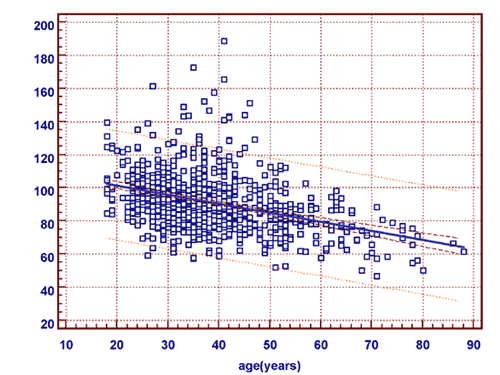3-3
Questions provokedaroused by estimated glomerular filtration rate in a
group of apparently healthy Chinese subjects
MA Ying-Chun, ZUO Li, WANG HaiYan
On behalf of Chinese eGFR Investigation Collaboration Group
Introduction:
The currently used normal reference range of creatinine clearance for
Chinese is 80-120ml/min, which was published more than half century ago.
With the recently developed equation of estimated glomerular filtration
rate (eGFR) for Chinese, it is needed to know the normal reference range
of eGFR by modified MDRD equation in apparently healthy Chinese subjects.
The preliminary result is reported here.
Methods:
Seven renal institutes participated in this study. A fasting plasma sample
was taken after a brief interview, during which demographic variables
were obtained, and physical examination was performed. Plasma was sent
to Peking University First Hospital for analysis of creatinine (Pcr, by
Jaffeユs kinetic method), urea nitrogen, albumin, triglyceride, cholesterol
and uric acid. eGFR was estimated using a modified MDRD equation for Chinese![]()
Eligible subjects were included if (1) they were normotensive, no positive
finding on physical examination; (2) fasting plasma laboratory showed
no hyperglycemia, hyperlipidemia, hyperuricaemia; (3) urine dipsticks
and sediments were negative. The following subjects were excluded: (1)
less than 18 years old; (2) history of diabetes mellitus, hypertension,
hyperuricemia, hyperlipidemia, liver disease, kidney disease; (3) currently
on any kinds of medication.
eGFR by age groups were reported,and its relationship with age was plotted.
Results:
Seven hundred and forty-seven subjects enrolled in the final analysis,.
Patients were assigned to 6 age groups, the eGFR by age group, percent
eGFR<60 ml/min/1.73m2 was listed in table-1.
The relation between eGFR and age was plotted in figure-1 (r = -0.38,
P < 0.0001). Our results indicated that the eGFR decreased with the
increase of age, the average value of eGFR decrease per ten years was
about 4.3 ml/min/1.73m2, and one-third subjects
of age 70 or higher had their eGFR less than 60 ml/min/1.73m2.
Conclusion:
Our preliminary results implied that a large portion of apparently healthy
elderly subjects had decreased eGFR according to Kidney Disease Outcome
Quality Initiative (KDOQI) clinical practice guidelines. Did they really
have chronic kidney disease or was this simply a physiological phenomenon
of aging? Should we develop specially an equation for, or change the normal
range of eGFR, in aging populations? More work is needed to answer these
questions.
Table-1. eGFR by age in apparently health Chinese subjects
| Age Group | Number (%) | eGFR( ml/min/1.73m2) | Number (%) of eGFR<60 ml/min/1.73m2 |
| 18-30 | 208(27.8) | 97.4±14.6 | 1(0.4) |
| 31-40 | 244(32.7) | 92.3±18.6 | 3(1.2) |
| 41-50 | 162(21.7) | 91.4±19.6 | 0 |
| 51-60 | 83(11.1) | 81.7±12.3 | 3(3.6) |
| 61-70 | 32(4.3) | 75.5±11.8 | 2(6.3) |
| >70 | 18(2.4) | 67.1±11.4 | 6(33.3) |
| Total | 747(100) | 91.0±18.1 | 15(2.0) |

Figure-1. Relationship between eGFR and age in apparently healthy Chinese subjects. The solid line represents regression line, dashed lines represent 95% confidence intervals for the regression line, and dotted line represent 95% confidence intervals for the estimated GFR value.